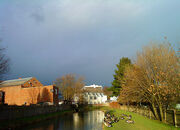
The section between Farm Road and Highfield Road in Enfield
The New River Path follows the course of the New River, an artificial waterway that was constructed to bring fresh water from Hertfordshire to London. Its source is the River Lee.
History
The concept for the canal's construction can be initially attributed to Edmund Colthurst in 1602, but he ran into financial difficulties after building only two miles of the canal. The project then came under the jurisdiction of Sir Hugh Myddelton who completed the work between 1609 and 1613. In 1611 Myddelton also encountered financial difficulties, but King James I agreed to provide half the cost of the works on condition he received half the profits and that the New River could be constructed through his palace grounds at Theobalds.
Parts of the canal have been modified since construction ended. One small section in Enfield Town was cut from the main flow, but remains as a local waterway known as the New River Loop. The canal also used to run down the centre of Petheron Road in Highbury, but this has been since been filled in and the canal's course diverted.
Access
The path runs between Hertford, Hertfordshire and Stoke Newington, London.
Not all sections of the New River are accessible to the public, so parts of the walk involve walking on the street. There are green signposts and small, green arrow signs which direct walkers to the next section. However, there are long gaps between some sections that are not signposted. It is recommended that you research your route beforehand.
The sections that are walkable generally involve grass and mud. Some sections have concrete paths. After bad weather some of the paths can become very muddy and slippery. The route is not accessible for bicycles, wheelchairs, or pushchairs due to kissing gates at most entry points.
Habitat
The path passes through various habitats. Some sections consist of grass and scrub while some sections border fields and woodland. One section borders Woodberry Wetlands. Because of this, different species can be expected in different areas. Wildfowl are always present but will move up and down the canal freely, especially in the spring and summer.
Species
As well as birds, the canal is also home to various species of fish including Pike and Roach. Grass Snakes have been seen in the Hertford section. Various species of dragonfly, damselfly, and other invertebrates can be found along the entire length of the canal.
Please note that these records are the personal records of one person, Katy McGilvray, and do not cover the entire length of the canal. Additions from other birdwatchers with different records are most welcome. Species that have been noted in various sections include (rare birds for that area are noted in bold):
Bullsmoor Lane -> Lieutenant Ellis Way:
Golden Plover (in nearby fields in winter), Jackdaw, Mallard, Starling
Palmers Green -> Enfield Town:
Black-headed Gull, Blackcap, Blue Tit, Canada Goose, Canada Goose/Greylag hybrid, Carrion Crow, Chaffinch, Collared Dove, Common Tern, Coot, Cormorant, Dunnock, Gadwall, Goosander (first noted December 2014), Great Spotted Woodpecker, Great Tit, Green Woodpecker, Grey Heron, Grey Wagtail, Herring Gull, Hobby, House Sparrow, Jackdaw (first noted September 2011), Jay, Kingfisher, Lesser Black-backed Gull, Lesser Spotted Woodpecker (Ford's Grove area), Little Grebe, Long-tailed Tit, Magpie, Mallard, Mandarin Duck, Mistle Thrush, Moorhen, Mute Swan, Pied Wagtail, Pochard, Redwing, Ring-necked Parakeet, Robin, Song Thrush, Sparrowhawk, Swift, Teal, Tawny Owl (Ford's Grove area), Tufted Duck, Waxwing, Woodpigeon
Green Lanes to Seven Sisters Road section (Chris Farthing personal records):
Blackbird, Blackcap, Black-headed Gull, Blue Tit, Canada Goose, Carrion Crow, Chaffinch, Chiffchaff, Coal Tit, Collared Dove, Common Gull, Coot, Cormorant, Dunnock, Feral Pigeon, Fieldfare, Goldcrest, Goldfinch, Great Spotted Woodpecker, Great Tit, Green Woodpecker, Greenfinch, Grey Heron, Grey Wagtail, Herring Gull, House Martin, House Sparrow, Jay, Kingfisher, Lesser Black-backed Gull, Lesser Redpoll, Little Egret, Little Grebe, Long-tailed Tit, Magpie, Mallard, Moorhen, Mute Swan, Pied Wagtail, Pochard, Red-crested Pochard, Redwing, Ring-necked Parakeet, Robin, Shoveler, Sparrowhawk, Starling, Swallow, Swift, Tufted Duck, Woodpigeon, Wren
Border of Woodberry Wetlands:
Black-headed Gull, Blackbird, Blue Tit, Carrion Crow, Cetti's Warbler, Chiffchaff, Common Tern, Coot, Cormorant, Feral Pigeon, Garden Warbler, Great Spotted Woodpecker, Great Tit, Greenfinch, Herring Gull, Jay, Lesser Black-backed Gull, Lesser Redpoll, Magpie, Mallard, Moorhen, Mute Swan, Peregrine, Ring Ouzel, Robin, Snipe, Sparrowhawk, Whitethroat, Willow Warbler, Woodpigeon, Wren